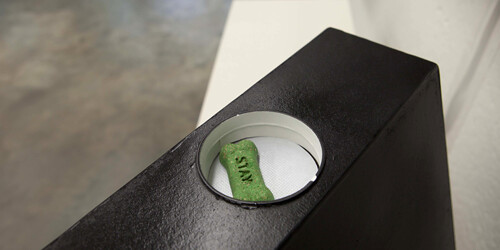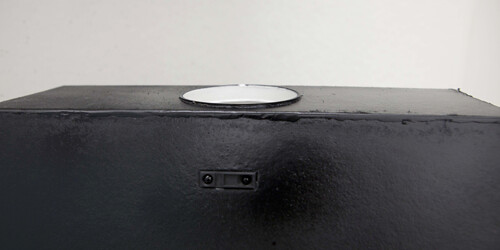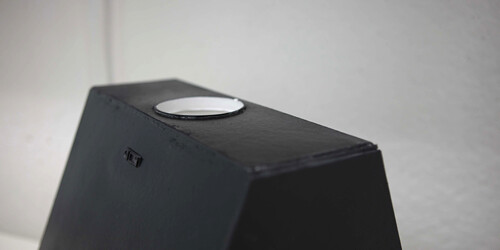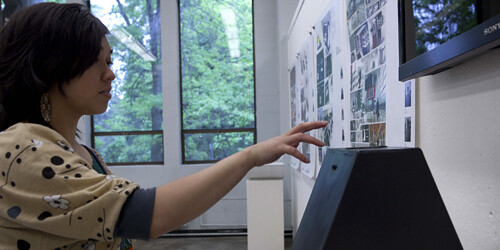Monday, August 22, 2011
Tuesday, June 7, 2011
Night Owl: A Storytelling Buddy
A storytelling nighttime friend, Night Owl uses an arduino to run an audio clip of any story uploaded to it. Just turn him on, and he'll help your child fall back to sleep at night. If you're still awake while his voice starts to quiet and his belly LED lights dim, just shake him and he'll go back to reading the story.

 Break Dancer Javon dances, activating the melody track, and then passes off the dance to Victor whos beat track then turns on.
Break Dancer Javon dances, activating the melody track, and then passes off the dance to Victor whos beat track then turns on.Go-For-It: Cierra Gonzales / Chris Rinker

We all know what dinner is like with dogs around. They will get as close as they can or even underneath the dining room table, waiting for the chance to snatch a piece of fallen food. To solve this toe nibbling issue we came up with an idea similar to Wack-A-Mole, but for dogs.
The unit includes an elevator comprised of a two-jointed lever, servo motor and platform. The unit also includes a Sharp proximity sensor that senses approaching objects or people. A treat is to be placed on the platform of the elevator so that is visible. When the dog identifies the treat and goes after it, the sensor senses the dog’s approach and the servo motor activates, dropping the elevator so that the treat is out of reach. If the treat is good enough, it could keep the dog’s attention for a while.




Elevator Mario: Scott Lui / Katie Hendricks
The Retracting Umbrella
ARDUAAMY: Expressive Hoodie
tupAWARE
ART387: Physical IxD
Instructor: Dominic Muren
tupAWARE is a smart food storage container that tracks the temperature and save time of a user's food selection, alerting them when their food is about to spoil or is already past it's acceptable save time.
tupAWARE from Mitch Johnson on Vimeo.
Powered by Arduino and temperature sensors, once the user has made a selection tupAWARE assigns an average save time to the category of food and subtracts time when the container is left in warmer temperatures for more than an hour. Normally food silently expires in the fridge, tupAWARE allows users to effortlessly know when it’s still safe to eat (green), when the food will expire the next day (yellow), and when the food is past it’s acceptable save time (red).




PB & A #5
With the source code for our project finalized about a week and a half ago and the literal schematic of hardware components and assembly completed shortly after, all that was left for us was to actually build our device and record it in use. After nine weeks of careful planning, about $300 worth of component purchases, over 120 feet of wiring, and nearly 60 hours of bread board assembly alone, we wound up with the physical guts of our smart table:
What we're looking at is a highly complex system of shift registers, FSR's, and LED outputs. The FSR's (hidden beneath the cylindrical columns shown above) constantly sense the weight of the pint in place, relaying differences in pressure as the pint is consumed to the attached Arduino. The Arduino interprets the sensor data and turns on LED indicators accordingly; when half a pint is consumed, a single LED is turned on, when a full pint has been consumed, two LED's are turned on. This process occurs constantly for each pint sensing station.
The largest column, in the middle of the table is the pitcher sensing station and the randomized pitcher purchaser selection initiator. When an empty pitcher is placed on the central column, a series of LED's turn off and on in a pattern resulting in something similar to a digital roulette. The LED's gradually slow down to a stop and one user is selected to purchase the next pitcher for the table.
After assembling the guts, the next step was to place the supporting table top structure. An enormous amount of time was spent in the school wood shop precisely cutting down various pieces of our device, ranging from weight supporting dowels, to table ends, to our peg board table top:
It was essential that we make sure the hardware of our device was functioning properly at every step of assembly. Here we are testing the light housings as we attach our peg board table top support:
In order to create the illusion of glowing pint glasses, we hand cut stencils and placed them between layers of thin, light diffusing paper, and thick, durable sheets of Yupo, a synthetic water resistant polymer:
The Yupo created an excellent water resistant layer that protected the internal components of our table from the inevitable spills sure to occur once our device was in action:
As a final test, before the protective layers of Yupo were attached to our top, we ran our device with pint glasses in place (successfully, first try!):
...and here is the final product:
With our device assembled, our code running perfectly, and our spirits high, it was time to test it in the field and film the results. Once we began, it wasn't long before we realized that our device was in all actuality, a wild success. As the afternoon progressed, our filming process became more of a documentation -- our actors became our users as they were thoroughly enjoying themselves while interacting with our device. It was clear to us that we were "on to something" with this project when a small crowd of bar patrons started to gather to watch us use our table! In fact, it became something of a nuisance as our filming was being constantly interrupted with questions, comments, and not so accidental walk-throughs.
The randomized selection of the person to buy the next round was by far the most successful aspect of our device. The reactions we got from our users justified the project entirely -- it was pure entertainment resulting from a social interaction enhanced through the use of our device.
This is the short film resulting from that experience:
...and a few shots of the device in action:


Again, the project was a wild success. It took an enormous effort to get to where we are today but we are very happy with the results. In fact, we're considering looking into getting a patent!
Fabricating Night Owl
Daniya and Alana
Boom!


Monday, June 6, 2011
Final Project: Neil Rhoades & Inness Wragg

Pitch is a way to connect more full with a large social situation. Ideal for restaurants and bars with a social atmosphere, it connects tables across the airwaves through live audio feeds. When the vessel is poured, its direction is associated arbitrarily with a feed from another pitcher, and it receives ten seconds of live audio. Users will learn how top manipulate Pitch to explore different feeds. This will create a more involved atmosphere connecting people to those around them and amplifying the existing feelings of excitement in a crowd.
The introduction of Pitch into a social space provide a basis for conversation within a table, as well as making patrons more aware of what's going on around them, and of themselves.


Friday, June 3, 2011
Week 10
Wednesday, June 1, 2011
Week 10: Neil & Inness

This weekend our team has been in and out of the wood-shop creating our base. We've completed our code and the electronic portion of our device, so that all we have to do is configure it in a way so it fits snugly into the base with a bit of padding.
We used yellow foam to form our base, trimming a block into a cylinder on the lathe and scooping out the interior with a drill press. We created a space for the speaker by drilling out a pattern of small holes from the interior to the exterior. We then painted and sanded to foam until it had a hard, smooth shell. We initially created a container with a lid to affix to the pitcher, but we used rare earth magnets to keep the container closed, which interfered with our compass sensor. Needing to change our strategy, we are now planning on flipping the container so the side that was at first the bottom will now be attached to the bottom of the pitcher. We will close the base by screwing in an acrylic circle with the same diameter as our base. With a bit more time in the woodshop and some drying time for adhesives, our prototype will be complete, and all we will need to do is make a video demonstration of the pitcher in action.























